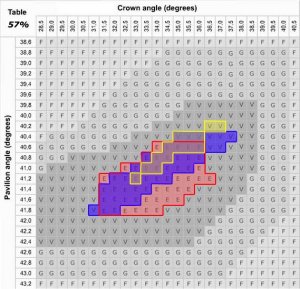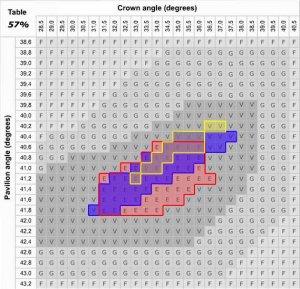Michael wrote:
One of my interests is appraising. Appraisers have a vested interest in understanding both GIA’s and AGS’s cut grading in order to do a proper analysis, just as they need to understand the grading systems for color and clarity.
_________________________________________
It appears that you don''t want to make the investment, that is needed to be able to render the predictions for the AGS cut grading.
I think most appraisers have, microscopes, that they use which have become their "right hand". If you walked into a gemologist/appraiser office and he/she only used a loupe and a set of CZ masters, I think most consumers who "appraised the appraiser" wouldn''t use the services of such a person.
With technology changing the way it has, the non contact proportion machine, and the AGS software is really necessary.
Then there is the committment to rendering the information that consumers want. I''ve made this investment for this equipment and more. As a result I am able to comfortably render these reports.
I don''t understand why a cutter wouldn''t add these items to his equipment, as well as jeweler or appraiser. Sure it is a lot of expense, but it provides consumers with the knowledge and confidence in one''s services, that they are on the level that they want. After all we do charge for this kind of work.
I guess my suggestion for you is if you want to appraise and analyze item to the extent that you want, bite the bullet and get the tools you need to do what you want. Increase your fees to pay off the investment.
I can tell you from working with these items, that it is more complex than using a chart or graph.... and in time as technology improves, you''ll be able to produce an even more detailed and accurate analysis, that without the items - is impossible to do.
I can''t see how making a chart in order to issue a grade can work. GIA''s charts, which I bought, basically do nothing more than take up space on the wall, and the computerized system of rounding up and using proportions that aren''t ACTUAL as the report says, can only end up with anyone using it, having the egg all over their face that GIA''s system does.
I''ve heard that the GIA computer program to do this costs $ 3000.00 plus a yearly fee.....AGS is a lot less, but still not a drop in the bucket, and it is certainly comprehensive an analysis.
Rockdoc
One of my interests is appraising. Appraisers have a vested interest in understanding both GIA’s and AGS’s cut grading in order to do a proper analysis, just as they need to understand the grading systems for color and clarity.
_________________________________________
It appears that you don''t want to make the investment, that is needed to be able to render the predictions for the AGS cut grading.
I think most appraisers have, microscopes, that they use which have become their "right hand". If you walked into a gemologist/appraiser office and he/she only used a loupe and a set of CZ masters, I think most consumers who "appraised the appraiser" wouldn''t use the services of such a person.
With technology changing the way it has, the non contact proportion machine, and the AGS software is really necessary.
Then there is the committment to rendering the information that consumers want. I''ve made this investment for this equipment and more. As a result I am able to comfortably render these reports.
I don''t understand why a cutter wouldn''t add these items to his equipment, as well as jeweler or appraiser. Sure it is a lot of expense, but it provides consumers with the knowledge and confidence in one''s services, that they are on the level that they want. After all we do charge for this kind of work.
I guess my suggestion for you is if you want to appraise and analyze item to the extent that you want, bite the bullet and get the tools you need to do what you want. Increase your fees to pay off the investment.
I can tell you from working with these items, that it is more complex than using a chart or graph.... and in time as technology improves, you''ll be able to produce an even more detailed and accurate analysis, that without the items - is impossible to do.
I can''t see how making a chart in order to issue a grade can work. GIA''s charts, which I bought, basically do nothing more than take up space on the wall, and the computerized system of rounding up and using proportions that aren''t ACTUAL as the report says, can only end up with anyone using it, having the egg all over their face that GIA''s system does.
I''ve heard that the GIA computer program to do this costs $ 3000.00 plus a yearly fee.....AGS is a lot less, but still not a drop in the bucket, and it is certainly comprehensive an analysis.
Rockdoc









300x240.png)